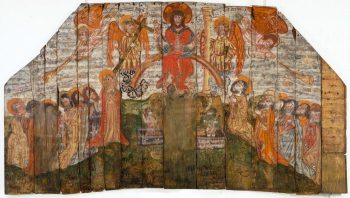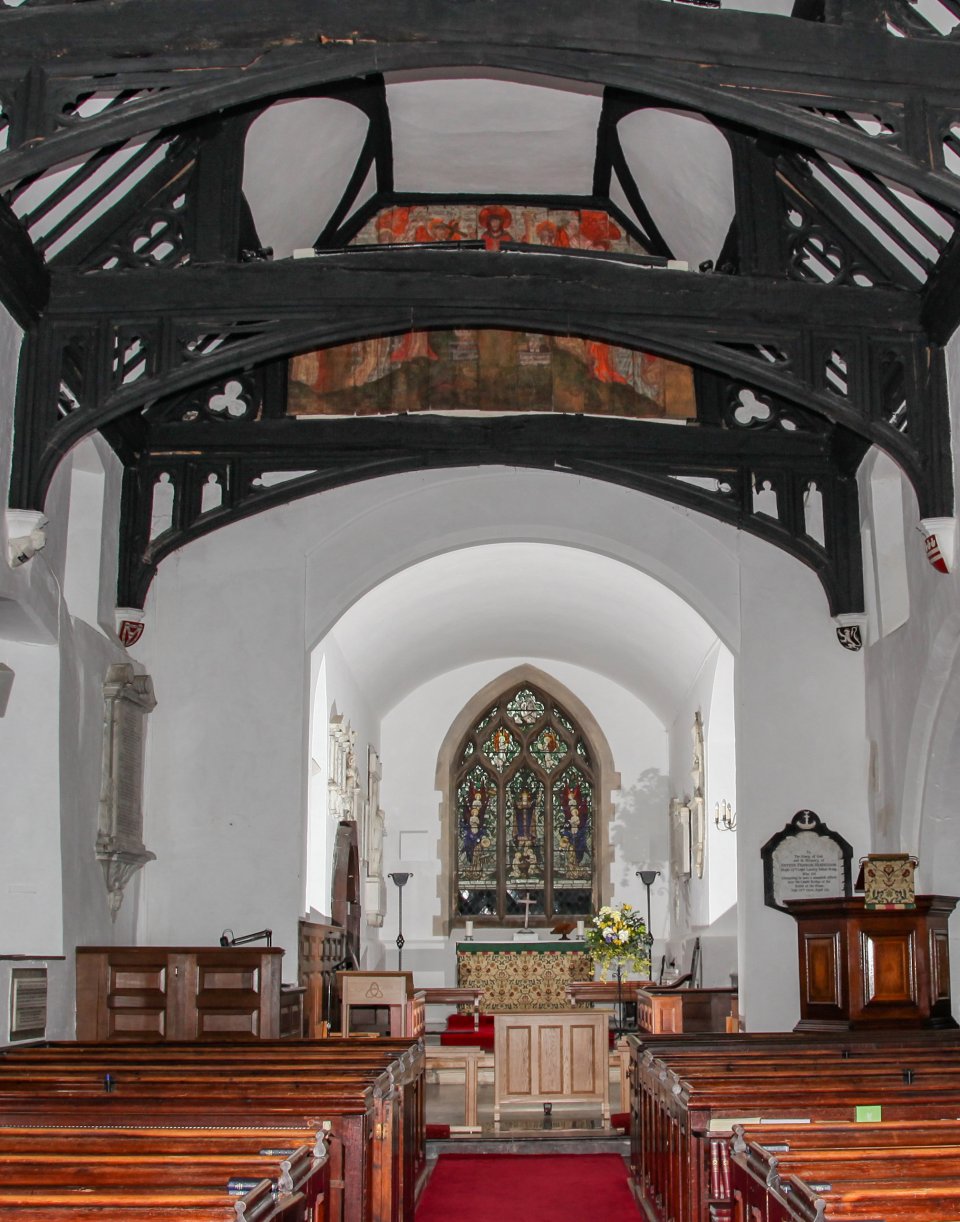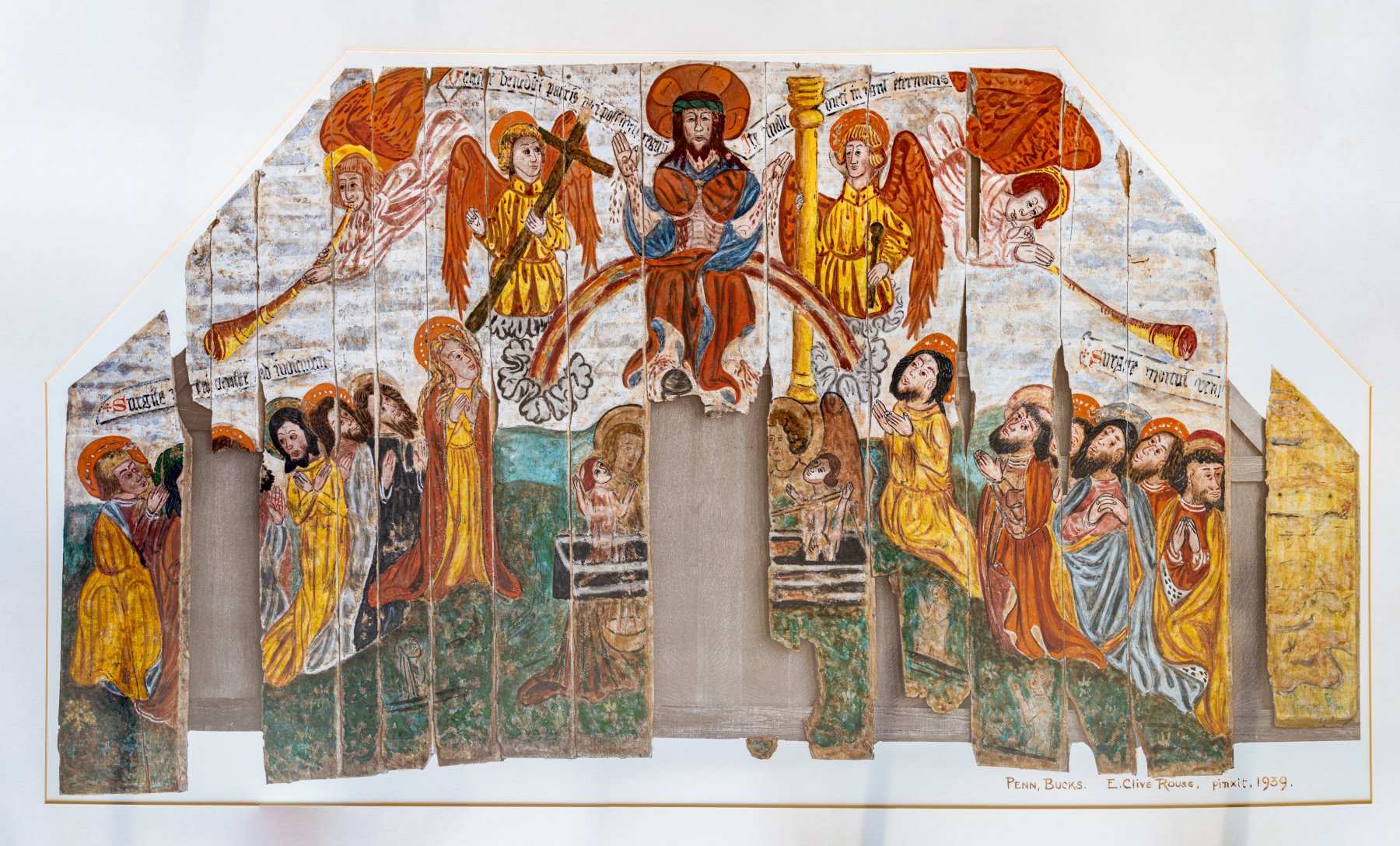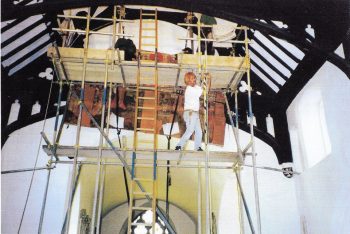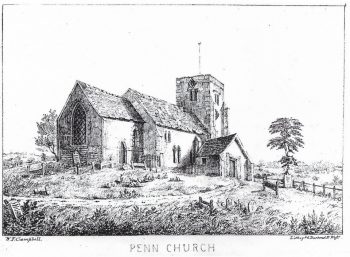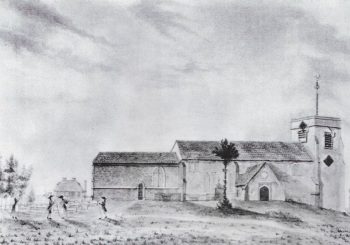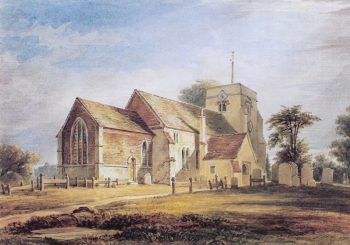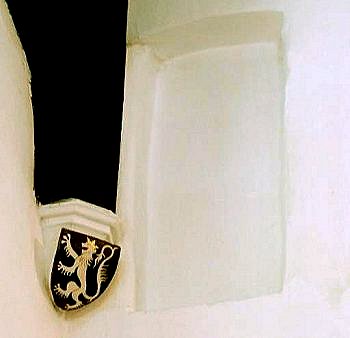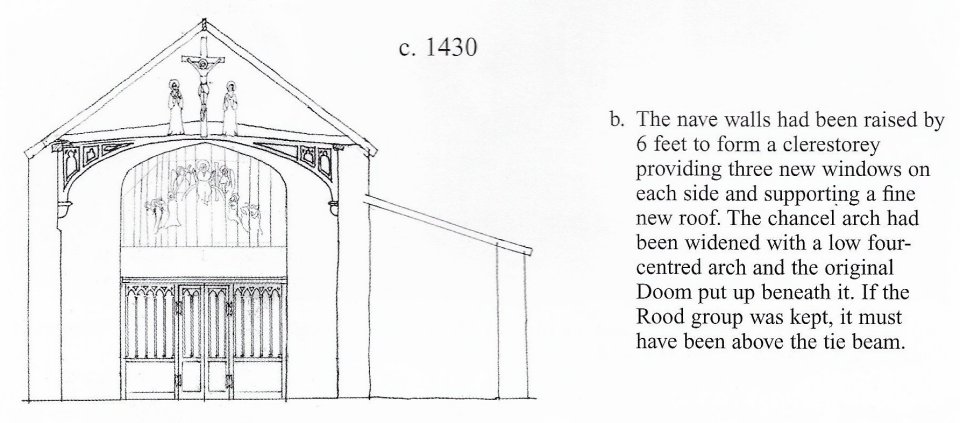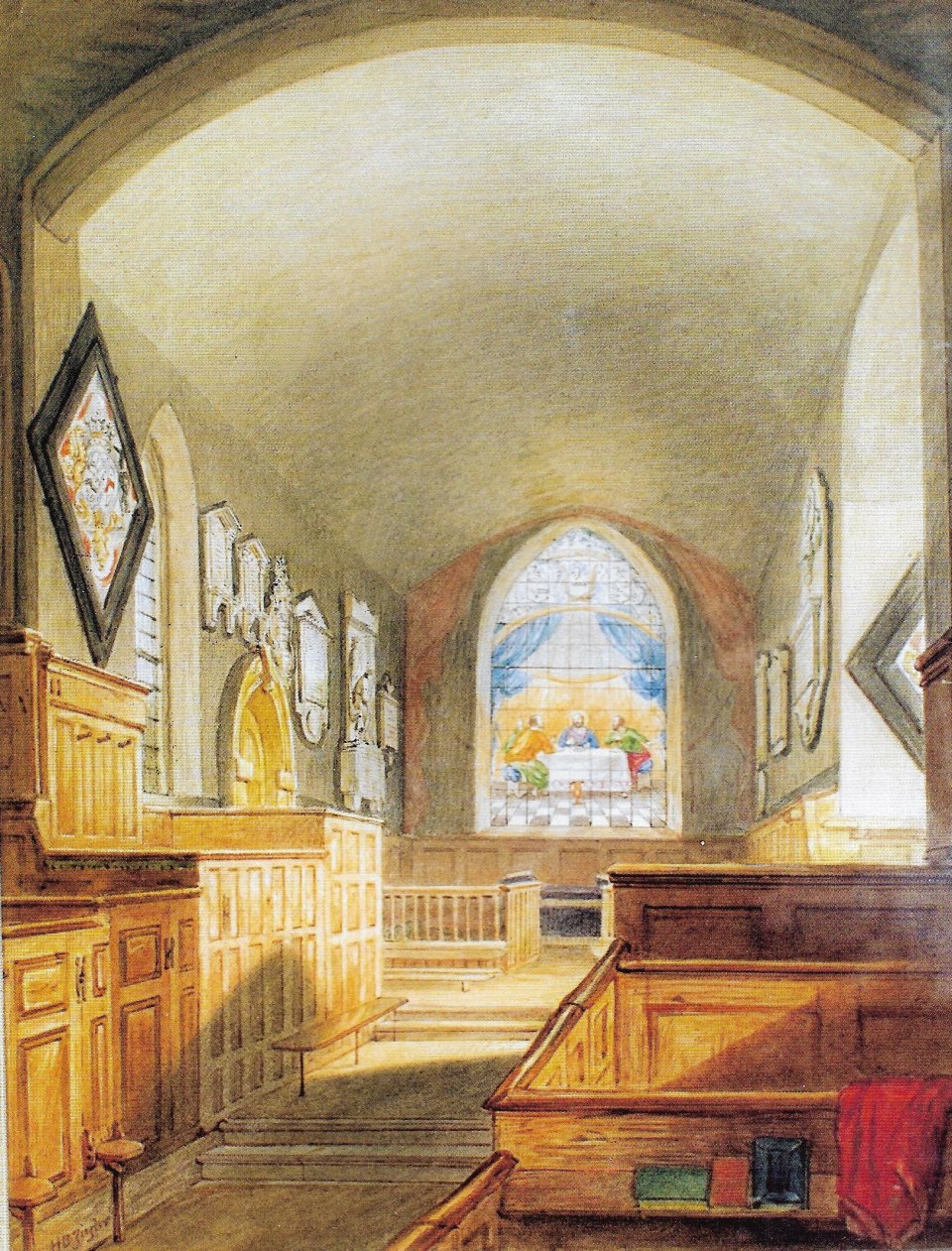THE PENN DOOM
Records of Buckinghamshire: Vol 44 (2004), Miles Green.
In 1938, Clive Rouse, a former editor of Records of Buckinghamshire and a leading expert on medieval wall paintings, reported the fortuitous discovery in Penn churchyard of the broken-up remains of a medieval painting of the Last Judgement in the form of a wooden. tympanum that had originally been set below Penn’s chancel arch. After reassembling all the pieces he could find and removing layers of whitewash and laths and plaster, cleaning and restoration revealed a second painting underneath the first. A Penn Church Millennium project has now funded further conservation work as well as a detailed analysis using the most modern techniques of paint analysis, infra-red, X-Ray and dendrochronology. The resulting insights have been combined with fresh architectural and historical evidence to provide as complete an account as possible of the painting and its setting. It is one of only five surviving medieval paintings of this type and, in Rouse’s expert view; incomparably the richest in colour. It was exhibited at the recent (2003) V&A exhibition, The Glory of Gothic: Art for England 1400-1547.
DISCOVERY IN 1938
In 1938, in the course of general decoration and repair, some badly decayed boarding, whitewashed and covered with lath and plaster, was forcibly removed from the easternmost bay of the roof of Penn Church, above the chancel arch (Figs 1 & 10). The old boarding was further broken up on removal and was pitched out into the churchyard, awaiting disposal on the local rubbish tip. It lay there for a week or more. Some pieces did find their way to the tip before one of the workmen happened to notice a painted face on a piece he took home for firewood, and it was not long before Clive Rouse was summoned. He was Assistant Editor of Records of Buckinghamshire at that time, and was also one of the leading national authorities on medieval church painting.1
He quickly recognised the importance of the discovery and after two days combing through the rubbish tip was able to assemble the planks and pieces in their original order in spite of much whitewash and laths and plaster still adhering to them. Some pieces were missing. He assembled a painting, about 12 ft wide and 6½ ft high, covering sixteen oak boards varying only slightly in thickness, but greatly in width from 4 inches to 1 foot 3 inches. The boards or planks were placed vertically and fitted together with an overlapping chamfer on each side (Fig. 2).
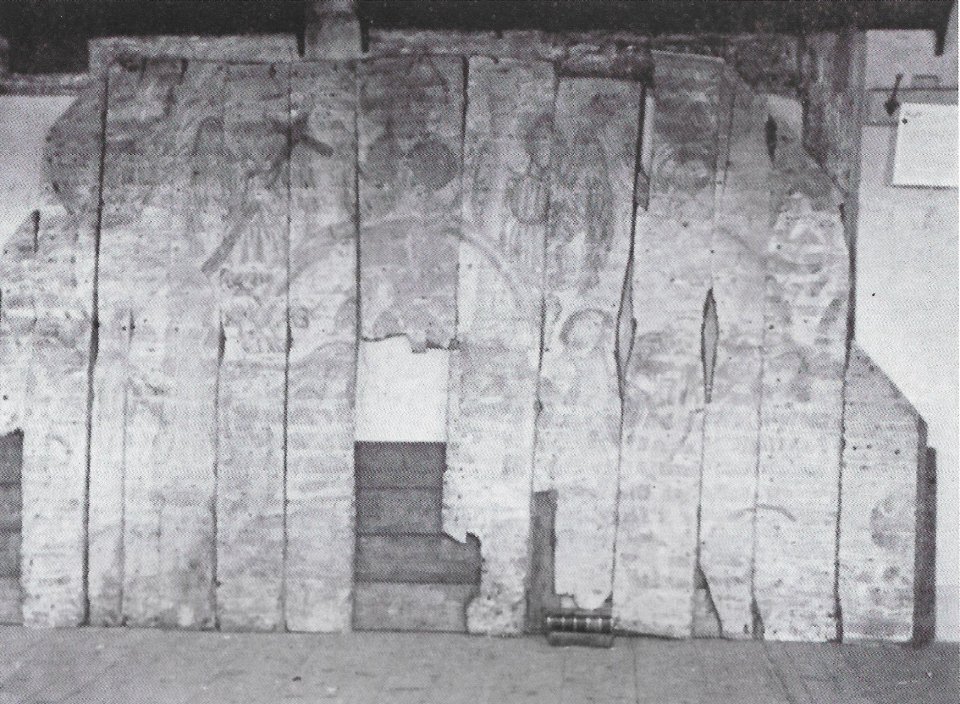
FIGURE 2 The Doom roughly re-assembled and freed oflaths and plaster and some whitewash, but before cleaning, immediately after discovery in 1938. (Clive Rouse).
Rouse cleaned and treated the painting, after which it was first replaced on the wall of the south aisle and later returned to where it had been found, above the tie beam. He recorded its salient points in Records the year after its discovery, but it was not until twenty-five years later that he wrote a full description of its iconography and his treatment of the painting.2
He emphasised its rarity as one of only five surviving medieval paintings of the Doom, painted on wood as a tympanum to go under the chancel arch, and incomparably the richest in colour. It was exhibited in the Victoria and Albert Museum c.1960.
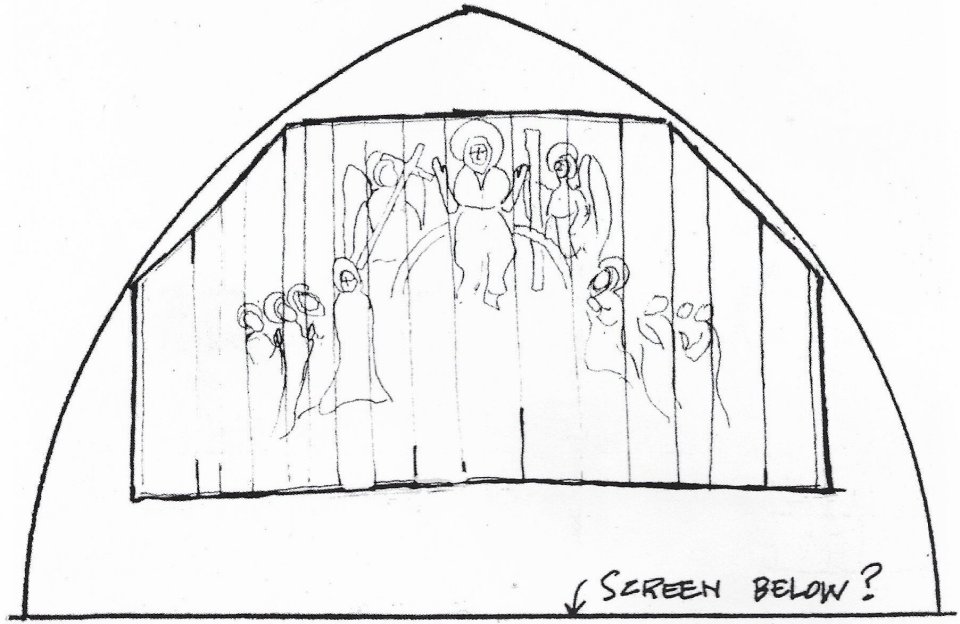
FIGURE 3 Clive Rouse’s sketch of how the present shape of the Doom would haw fitted into a medieval pointed arch. He assumed that the original Doom had been drastically cut down all round in order to fit into the roof space above the chancel arch where it was found. (Redrawn by Mike Lamont).
He found that the painting was a palimpsest – an earlier work of great delicacy and more elaboration, executed he thought, in tempera (egg), had been overpainted by a later but coarser painting in crude but brilliant oil colours. He deliberately removed some of the plain painted areas of the second painting in order to reveal some crucial elements of the first. He concluded that the original painting had been a true tympanum fitting under the upper part of the medieval chancel arch, extending up into its arched apex, and widening out to its sides (Fig 3).Rouse dated it to the end of the fourteenth century, pre-dating the fine early fifteenth century roof, and suggested that about a century later, for some reason unknown, the painting had been taken down from under the chancel arch, cut to fit the roof space above it and repainted to make it more visible in its new and lofty position. This article, with the benefit of the technical analysis described below, proposes a rather different sequence of events.
A Millennium re-examination
In 1999, the Penn Trust, a local charity, offered to pay for a technical examination and full report on the Doom to establish whether any conservation measures were needed and to find out more about the painting. This work was carried out in situ by Ruth E. Bubb, a conservator of paintings. In the light of her report it was decided to remove the Doom to her studio near Banbury in order to facilitate cleaning and treatment and allow a close analysis using all the modern techniques available (Fig. 10).
Detailed analyses of the paint layers, infra-red reflectography, X-radiographs and dendrochronology have all been carried out and have revealed much of interest. The plain wooden inserts, which fill gaps where parts of the original boards are missing, have been replaced by better fitting ones treated to make them less conspicuous and a new, much lighter, aluminium framework has been designed to support the painting.3
The Victoria and Albert Museum displayed the newly conserved Penn Doom in their exhibition, The Glory of Gothic: Art in England 1400-1547, from October 2003 to January 2004.
What follows is an attempt to combine the new insights produced by the technical analysis with fresh architectural and historical evidence to provide as complete a story of the Penn Doom as possible.
A drawing of the late medieval church
A lithograph of the exterior of Penn Church (Fig 4), which was published in about 1800, is based on an earlier drawing of the church made at what appears to be some time in the seventeenth century.4 It may well have been taken from the framed picture which used to hang in the Vestry, described in 1929 as ‘the exterior as it appeared before the Chancel was added in 1733’.5
It is well established that churches were generally neglected during the 150 years of religious turmoil following the Reformation in the mid sixteenth century, and there is a 1637 Bishop’s Visitation report which confirms that Penn was no exception.6 There is no visible sign or written record of any change to the church fabric in those centuries and it is reasonable to assume that the lithograph records the external appearance of the late medieval church.
The Doom as a tympanum until the 1730s
The seventeenth century view (Fig 4) shows that the ridge of the nave was over 3ft lower than it is now, whereas mid-eighteenth and nineteenth century views (Figs 5 & 6) show the ridge at its present height.7
Therefore, it must have been during the major restructuring of the church, shortly after Sir Nathaniel Curzon inherited the proprietorship of the church, in 1731, that the ridge height was raised. This allowed the nave roof to be continued over the south aisle, presumably in order to raise the height of the roof of the south aisle, in which the pews of the Curzons and other leading parishioners were to be newly positioned. It also made the roof more weather proof – the 1637 Visitation had reported ‘It rains into the S. aisle!!!’. It had the disadvantage of covering over all the clerestory windows of the nave on the south side (Fig.7e).
Sketches of the church (Figs 7d & 7e) show what effect these alterations had on the internal arrangements of the roof, the chancel arch and the position of the Doom. The lower half of the medieval double’ truss nave roof was not affected and the tiebeams, arch-braces and corbels were not moved. The upper half of the roof must have been rebuilt, no doubt reusing timber where possible.
The Doom fits closely into its present position above the tie beam, but it is clear that there would not have been enough room to do so until the roof was raised in the 1730s. It presumably remained ill situ under the medieval chancel arch until then. This conclusion is supported by the report of a Bishop’s Visitation to the church, in 1637, which referred to ‘the wainscot which is over the separation of church and chancel’ and required it ‘to be made up decently as in former times’.8 After the Reformation, tympanums were generally kept as a convenient hoarding for the newly obligatory 10 commandments or royal arms, but many were lost to the Victorian restorers.
Chancel and chancel arch
In 1733, the huge family pews of the Curzons and two or three of the other leading parishioners were taken out of the chancel and put in the south aisle.9 The eastern arch of the south aisle was drastically widened by five feet to allow them a good view of the pulpit, and a public gallery was built above the west door. The nave roof was raised and three years later, the whole chancel was effectively rebuilt in brick, keeping only the lower part of the medieval side walls. The chancel was also lengthened by about 8 ft (compare Figs 4 & 5), presumably in order to make room for a three-decker pulpit (Fig.8).10 The chancel arch was widened a little to the south (hence the narrower south wall of the chancel arch). This was all part of a typical eighteenth century conversion to an auditory church with its emphasis on hearing and seeing the preacher, not on the mysteries taking place in the chancel behind a screen, which had apparently been restored in Penn twenty years earlier.11
The present segmental chancel arch is the one built in 1736, lowered by about 2 feet, in 1967, to conceal new electric lights. We have no record of the shape of the late medieval arch, which preceded it since the upper part of the wall in which it is set was completely rebuilt in brick in 1736. However, we also know that whenever a low arch was needed, English masons almost always preferred four-centred arches of which the low or depressed type is more common (Fig. 9).12
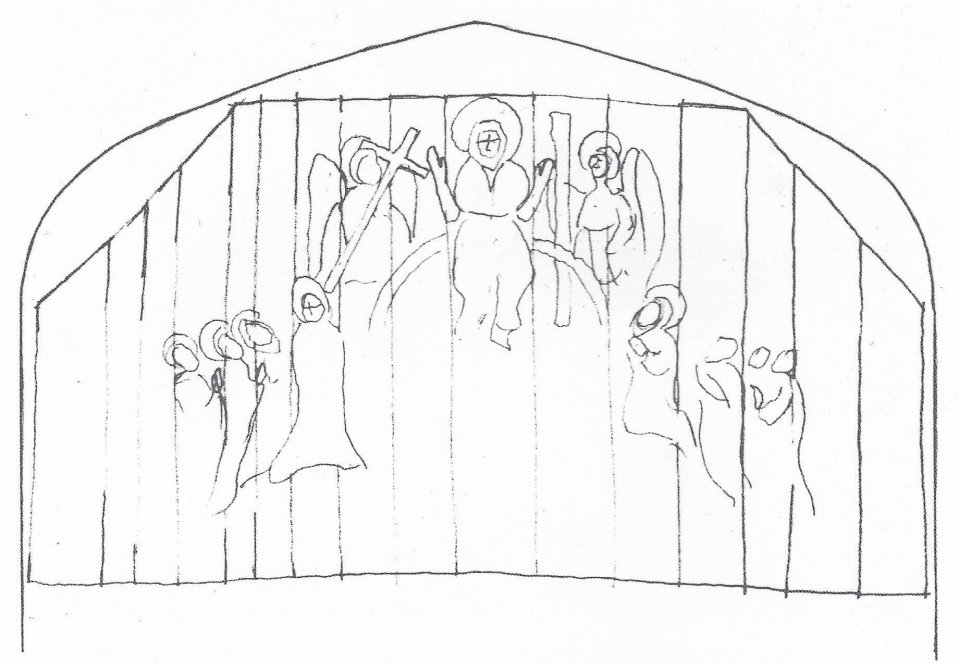 Just such an arch is formed by the braces under the tie beam which is likely to have been put up at the same time as the new chancel arch. It is not as strong as a more pointed arch (such as assumed by Rouse, Fig. 3), but stronger than the present segmental arch. Little strength is needed because it is not carrying any of the weight of the roof, only a short height of thin brick gable wall. The width of the lower part of the late medieval chancel was, and still is today, 13 ft. The present chancel arch is 12ft 8ins wide. The late medieval chancel arch must have been only a little over 12 feet to accommodate thc Doom (which, it is argued below, was only an inch or two wider than it is now), and about the same height as today to allow room for the Doom to fit on top of the Rood loft and under the chancel arch.
Just such an arch is formed by the braces under the tie beam which is likely to have been put up at the same time as the new chancel arch. It is not as strong as a more pointed arch (such as assumed by Rouse, Fig. 3), but stronger than the present segmental arch. Little strength is needed because it is not carrying any of the weight of the roof, only a short height of thin brick gable wall. The width of the lower part of the late medieval chancel was, and still is today, 13 ft. The present chancel arch is 12ft 8ins wide. The late medieval chancel arch must have been only a little over 12 feet to accommodate thc Doom (which, it is argued below, was only an inch or two wider than it is now), and about the same height as today to allow room for the Doom to fit on top of the Rood loft and under the chancel arch.
Tympanum
The Doom, before it was cut down, would have needed only a few extra inches at the top, at most a foot at the highest point, to have fitted neatly, as a tympanum, under the proposed four centred chancel arch. The purpose of a tympanum was to block the light from the chancel’s east window, which generally increased steadily in size during the Middle Ages, as did the chancel arch, both reaching a maximum during the fifteenth century. This meant that the Great Rood, the central focus of worship for the congregation, which hung at the chancel arch, was ‘haloed’ against the light and could not be seen properly. The tympanum both shut out the light and provided a background to set off the Rood, with well placed natural light provided by new clerestorey windows, as in Penn.13
Rood loft and group
We know that Penn had a Rood loft. This is confirmed by two wills of 1513 and 154914 , which left money to ‘the Rood light of Penn’, and by the discovery, in 1951, of the narrow (about 1ft 8ins wide and 4 ft 6ins high), entrance to the loft through the east end of the south nave wall, at the same level as the clerestorey windows (Fig. 10).
Since the roof of the medieval south aisle was below the clerestorey windows, the rood loft entrance must have been reached by a spiral staircase, entered from the Lady Chapel or the south aisle. Viewed from outside, the staircase turret would have appeared out of the aisle roof attached to the outside wall of the nave. This was a very common arrangement. That part of the outside nave wall is still very uneven indeed, entirely consistent with the removal of an earlier staircase. There may have been a small window at the top of the turret to light both stairs and loft (Fig.7c, below).
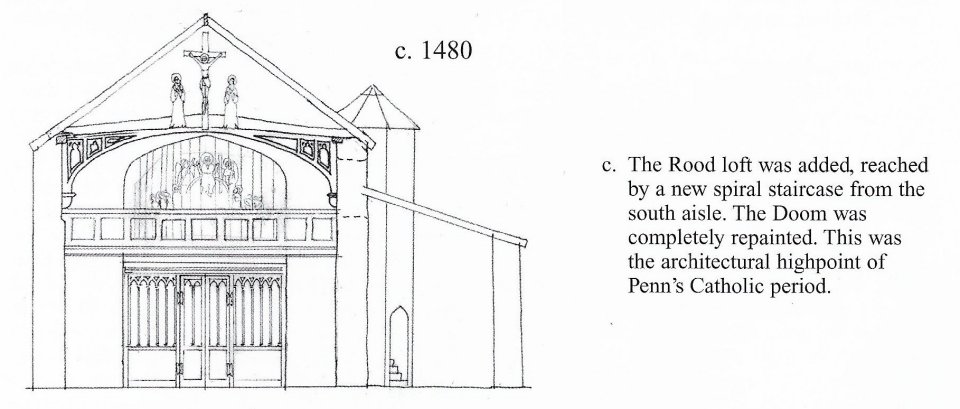 A Rood loft was typically a railed platform of wooden planks, from about three to six feet wide, running across the width of the nave and supported by two wooden beams, the Rood beam next to the chancel arch, and the candle beam at the front. The Rood beam normally also supported the carved wooden figure of Christ on the cross, known as the Rood, with its accompanying figures of John the Evangelist and the Virgin Mary. All would have been painted and gilded, about life-size, the central focus of worship, dominating the nave. There are still two pairs of hooks on Penn’s tie-beam adjoining the chancel arch from which basins once hung containing the tapered candles which were kept burning continuously both there and on the top of the candlebeam railings.
A Rood loft was typically a railed platform of wooden planks, from about three to six feet wide, running across the width of the nave and supported by two wooden beams, the Rood beam next to the chancel arch, and the candle beam at the front. The Rood beam normally also supported the carved wooden figure of Christ on the cross, known as the Rood, with its accompanying figures of John the Evangelist and the Virgin Mary. All would have been painted and gilded, about life-size, the central focus of worship, dominating the nave. There are still two pairs of hooks on Penn’s tie-beam adjoining the chancel arch from which basins once hung containing the tapered candles which were kept burning continuously both there and on the top of the candlebeam railings.
The Rood group, tympanum, tie-beam roof, Doom and loft were all separate developments over time and did not all exist together in parish churches until the second half of the fifteenth century, Rood groups go back to the twelfth century and earlier; tympanums were needed as the size of the chancel window grew from the late fourteenth century onwards; Penn’s type of tie beam roof belongs to the early fifteenth century; the Doom is dated by dendrochronology (see below) to 1414-48, Rouse observed that the complex of tympanum, Doom and Rood screen and group did not occur regularly much before c.1400.15 Rood lofts only became general in parish churches in the latter half of the fifteenth century.16
The Rood-group would probably have hung from the tie-beam in front of a blank tympanum before the Doom was painted, but a central Rood group, with the base of the’ cross supported by the loft platform, would have stood right in front of the Doom painting (Fig 7d), Analysis of paint samples, confirmed by x-rays and infra-red photographs, have shown that no spaces were left blank on the earlier Doom to accommodate the Rood group, as is often the case elsewhere. We must therefore conclude that either the Doom was a substitute for the Rood, or that the Rood group was fixed above the Doom. This would have been unusual but possible, since, although the medieval roof was some 3 feet lower than now, there was probably no ceiling as there is now, and the roof would have been open to the rafters, This would have given about 6 ft above the tie-beam up to the ridge beam, sufficient for a Rood, which could have hung on chains from the rafters or stood on the top of the tie-beam (Figs 7b&c).17
There is a slot in the bottom, centre of the tie-beam, and another groove on the nave side of the tie-beam, slightly off-set from the slot, either of which would have secured the vertical beam of the Rood and the top of the Doom.
In order to give enough room for the Doom, the loft platform must have been about a foot or two below the rood loft entrance, from which wooden steps would have descended. It was not structurally possible to put the loft entrance level with the loft platform since it would have meant removing the wall just below the load-bearing corner corbel as well as below the new clerestorey window. Its position on top of the old wall, level with the window, avoided these structural problems (Fig. 10).
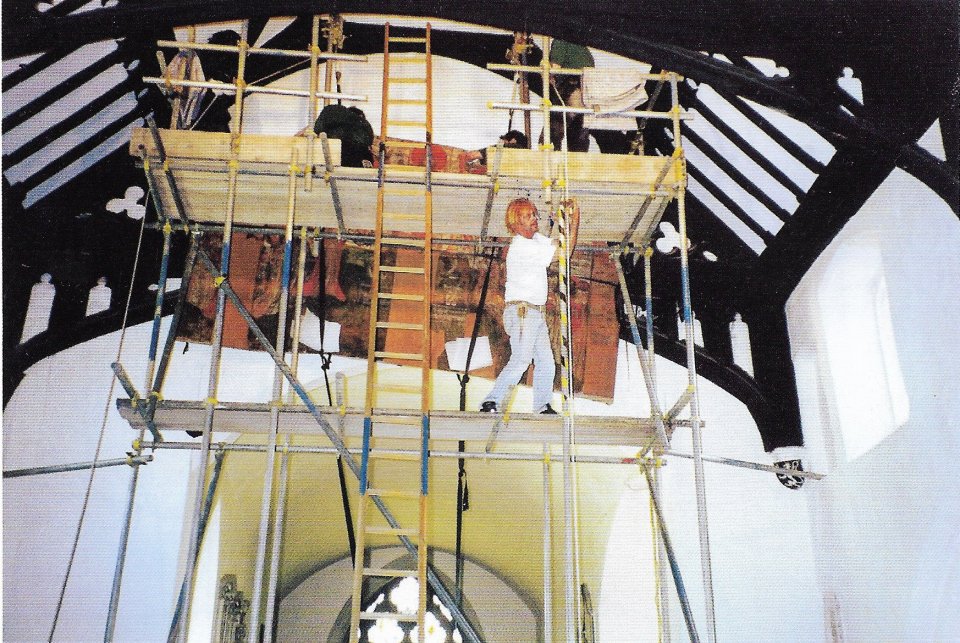
FIGURE 10 The Doom being taken down from above the chancel arch prior to its recent examination and conservation. To the right can be seen the Rood loft entrance set between the corbel supporting the tie beam and a clerestorey window. (Photo by John Wood).
The loft platform might have been lower still because the congregation’s view of the Doom would have been obscured to some extent by the loft railings unless the Doom was suspended at least 2 feet above the loft platform, but blocking the light may well have been more important. The discovery of the ends of the former Rood beam or candle beam in the wall below the loft entrance would settle the matter. We should bear in mind that there would have been a Rood screen below the loft and that the nave floor was then a good 18 inches lower than it is now. The bottom of the Doom would have been about 12 feet above the nave floor.
A narrow Rood loft entrance with steps down to the loft platform would not have been the most convenient arrangement for a priest in his bulky vestments, but the main purpose of Rood lofts was to accommodate the singers and musicians as the plain song and unison, involving only priest and clerk, evolved, during the fifteenth century, into part singing needing more voices. The loft was ideally placed for the singers to see and hear both priest and congregation and lead the singing. The use of the loft for Rood lights and the Easter veiling of the Great Rood was secondary.18
The original Doom
The evidence from dendrochronology is that, between 1414 and 1448, a single local oak, about 100 years old and with a diameter of about 2ft 6ins, was felled and a length of between 7 and 8 feet, equivalent to the intended height of the Doom, was sawn off.19 This length was then split in two using wedges and split again successively into 1/4s, 1!8ths, 1/16ths, 1/32ths and so on to produce 16 wedge-shaped boards of varying widths, the widest being 1ft 3in (half the diameter of the tree). These were planed flat, most of the soft sapwood on one side removed and a chamfer put on each edge. They were assembled whilst the. wood was still green. This was very much a vernacular product and would only have taken experienced local carpenters about a day to make.20 Clive Rouse suggested, on stylistic grounds, a slightly earlier date of c.1400 for the first painting.
The Doom today is 12ft wide and 6ft 6ins high. There seems to be nothing missing from the iconography of the original painting, apart from the tip of an angel’s wing cut off on the top and dexter (i.e., the left as you look at it) sides. This assumes, as Rouse suggested, that the scrolls appear to be a substitute for the more usual processions to heaven and hell or that the processions were painted on the wall on each side of the chancel arch, as was often the case. Making appropriate allowances for the angel’s wing and for the inaccurate spacing of the planks on each side, and assuming that the figure of Christ on the widest panel is at the centre of the picture, we need add only an inch or two to its present width and height to have the complete picture.
This suggestion has been supported by the dendrochronologist’s close examination of the wood. He found that the dexter panel was the only one turned so that its harder edge was on the left, i.e., on the outside of the painting. This suggests that it was intended as the end panel. It has about half an inch of rings missing in comparison with neighbouring boards. He also found that the end panel on the other side did not come from a local oak like the rest, but was imported Baltic oak a little older and probably taken from a door or other piece of furniture since there is a rebated ‘tongue’ on the outside edge. It is very unlikely to have been part of the original painting, but was more probably a repair.
The original artist, about whom we know nothing other than the evidence of his work, which was accomplished and delicate, composed his picture using traditional oil-based paints. The finished Doom was then fitted under the top of the chancel arch replacing the existing Rood group, which may then have been fixed above the tiebeam. There would have been a rood screen below, but not yet a rood loft (Fig. 7b). The rather clumsy arrangements for the Rood loft entrance discussed above, suggest that it was not part of the original design when the clerestorey was first raised.
The Doom repainted
Analysis of the paint layers suggests that the repainting, for which Rouse proposed a date of 1480, was needed because the gold (actually yellow orpiment) paint of the haloes and the angels’ hair had blackened as had the scales for weighing the souls, and could no longer be seen against the predominately black hill where it was taking place. The sky of the first painting was a much darker blue and a lot of green was used for the figures whose costumes were generally paler than they are now, though all the figures originally had brilliant yellow haloes bordered with red lead. The general effect of the painting, by 1480, would have been extremely dark and difficult to read 12 feet above the nave floor, due to the blackening of the lead pigment, especially if was now to be partly obscured by a rood loft balustrade (Fig. 7c ).21
Fig.11 gives an impression of this first colour scheme. reconstructing the main features of the first composition where they differ significantly from the second scheme, but elsewhere using the features of the second scheme. It does not pretend to be an accurate reconstruction.22
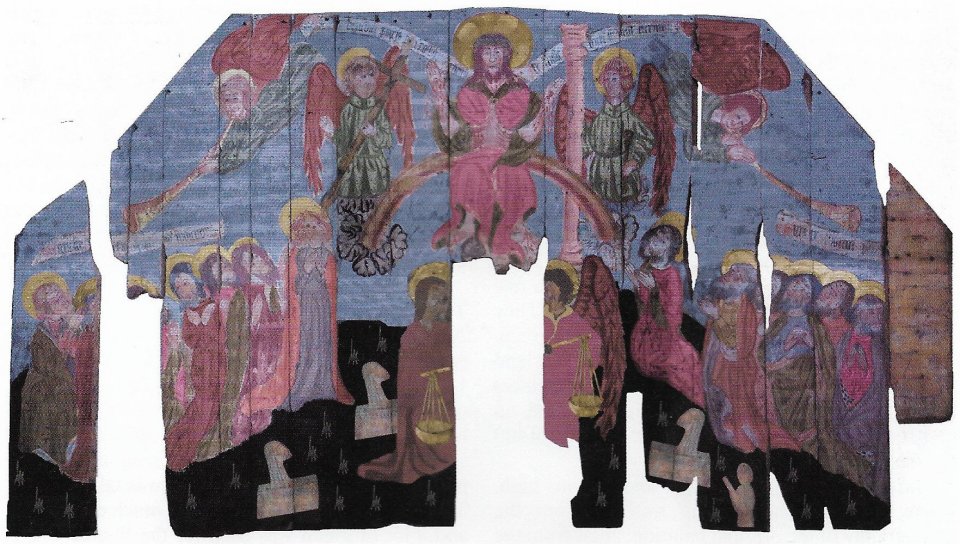
FIGURE 11 A digital impression of the main features of the first Doom painting by Clare Richardson. (Ruth Bubb).
A considerably less skilful artist, who painted in situ as evidenced by vertical runs of paint, radically transformed and simplified the original painting by heightening the formerly black hill and painting it green (oxidisation has since darkened and browned the original powerful colour), obliterating the striking red and pink figures of Mary and St Michael, the gold scales and the five or six little souls in their tombs, replacing them with just two larger souls.
The bottom half of the central plank below the figure of Christ is the major missing piece of the painting. The concealment of the original several small resurrected souls and their replacement by a larger one each side of the central that the plank may have been deliberately left blank, perhaps to permit a centrally placed post for the railing of a new Rood 10ft.23
In the upper part, the sky was repainted in a paler blue, covering the explanatory scrolls which called the dead to rise and come to judgement, consigned evil-doers into eternal fire and summoned the blessed to inherit their kingdom. Rouse suggested that the unusually full texts of the scrolls in the earlier painting might have been a substitute for what he described as the remarkable omission of the usual images of the processions of the Damned to Hell and of the Blessed to Heaven. It may well be that the scrolls were left out of the repainting was because processions were added on the wall on each side of the chancel arch, as has been found elsewhere. Much wall painting has been found on the nearby walls of the nave, but unfortunately, paint analysis has established that the chancel arch walls had been comprehensively replastered.
All the remaining figures, including the central Christ seated on the rainbow, were repainted, generally following the original lines, but with coarser features and an astonishing and unusual palette of much brighter and expensive colours, pinks, blues, reds and yellows with alternate red and yellow haloes. The result was a cruder painting but one that was much easier to read from the floor of the nave. Evidence that wet paint was worked into still wet lower layers shows that the repainting was carried out very rapidly.
Proposed sequence of changes
The most likely sequence of events, suggested by combining the results of the technical analysis of the Doom with architectural and historical evidence, is illustrated in Fig. 7 and would seem to be as follows:
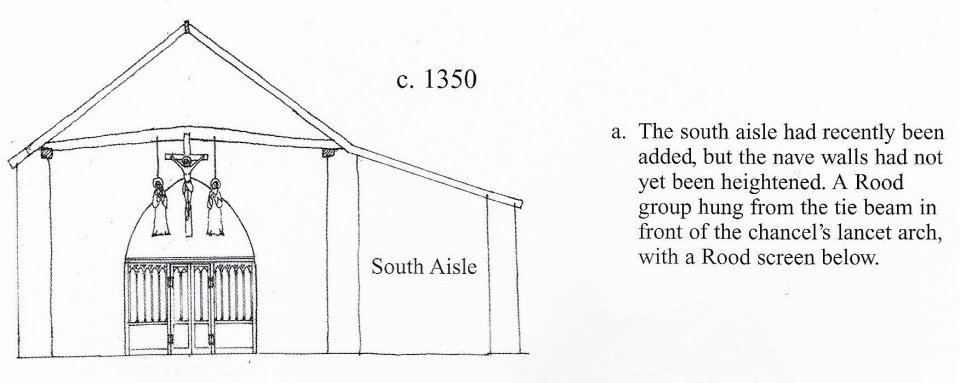
-
-
1350. (Fig. 7a) There was no clerestorey and the roof of the nave was about 9ft lower than now. The chancel was probably only about 10 feet wide (now 13 ft) and the chancel arch was probably similar in shape to the surviving early fourteenth century lancet arch at the west end of the nave, which is only about 8 ft wide and 12 ft high. A Rood group would have hung above the chancel arch from the tie beam.The narrow south aisle had recently been added to cater for a population that was growing steadily up to the start of the Black Death in 1348, as well as to meet the need for the more elaborate processions and ritual of the time. The Penn tilers were flourishing at this time and so funds would have been more readily forthcoming from the parishioners.24In 1952, Clive Rouse saw the chancel walls stripped of all plaster and observed that it looked as if they had been rebuilt in the Middle Ages. The Priory of Chalcombe had just had its ownership of the church confirmed by the Pope and may have enlarged the chancel by moving the south wall further out by 3 ft or so, to its present 13 ft.25 This is why the ridges of the chancel and nave roofs are some 18 inches out of line when viewed from outside.26
-
In the early 15th C, (Fig. 7b) the nave walls were raised by some 6 ft to form a clerestorey 27. The fine new queenpost roof rested on top of the heightened walls supported and strengthened by the corbels, arch braces and tie beams that we see today. The wider chancel allowed the chancel arch to be widened to just over 12 ft wide and heightened, probably employing a low four-centred arch. The Doom was put up as a tympanum, at some time between 1414 and 1448 well lit by the new clerestorey windows. There was not yet a Rood loft. These alterations were entirely typical of the fifteenth century, when the aim was to make churches lighter and more open, often completely removing the chancel arch to achieve this effect.The parishioners may have paid for some or even all of this work, but there are two obvious possible benefactors. The Pennes of the time who were lords of the manor and were a prosperous knightly family representing the county in Parliament; and Chalcombe Priory as the proprietor of the church. Both may have contributed although no evidence survives.There is also indirect evidence of the possible involvement of another wealthy patron, Joan, the widow of Sir John de Mohun (1320-75). The Mohun shield was identified on the corbel in the North West corner of the nave when the corbels were all cleaned and repainted in 1952. Sir John was a follower of the Black Prince and one of the original knights of the Garter, only the eleventh to be so honoured. His small wooden shield with the same coat of arms as on the Penn corbel can still be seen amongst the Garter stall-plates in St George’s Chapel, Windsor. His mother was the daughter of Sir John de Segrave who held the Segrave manor in Penn until 1325.His widow outlived him for 30 years and lived much at Court, where her daughters had all made grand marriages, one to Edward, Duke of York. It is known that she built and endowed a chantry chapel in Canterbury and she may well have contributed in a more modest way to Penn. Neither she nor her immediate family still held Segrave manor and there would not seem to be any good reason for including the Mohun shield on what are likely to have been new corbels, other than as a permanent acknowledgement of an honoured benefactor. She died in 1405, and this fits with the early fifteenth century date suggested for the new roof.28
-
1480 (Fig. 7c), it seems likely that the Rood loft was added, reached by a new spiral staircase from the Lady Chapel or south aisle. This allowed the Doom to be more easily repainted in situ (Fig 12). Clive Rouse suggested 1480 for the repainting, based on comparative stylistic grounds.The repainting was not a consequence, as has been thought, of moving the Doom up to where it was rediscovered above the tie beam and thus needing a more visible, simpler and brighter painting. There was not enough room to do this until the roof was raised in the 1730s. The repainting seems to have been a consequence of adding the new Rood loft which then provided a convenient platform for a badly needed repainting of a Doom that was by then was very dark and difficult to read due to the blackening of the lead pigments. There may also have been a need to take account of the railings of the new loft in the redesign of the painting.
- Before the 1547, the Doom was repaired. This is indicated by analysis of the paint layers, which found similar yellow-paint splashes on the Baltic end panel and on its neighbour that had been added prior to the Reformation limewash. This suggests that the Baltic timber was already in situ in the late Middle Ages, presumably as a repair some time after the second scheme had time to deteriorate because of damp or wear.
- 1547-8, immediately after the death of Henry VIII, the Protestant Reformation of Edward VI was in full swing and a royal visitation was decreed with Commissioners appointed to visit every church in the land. The Commissioners were required to enforce sweeping changes, which included the banning of all Rood lights and the destruction of images. The Rood loft and screen may have survived at this stage. The Doom was not removed but instead was concealed under a coat of whitewash. It may be that this was in order to save a valued painting that might be needed again, given the uncertain religious climate. More probably, it was the easiest thing to do and had the added advantage that it could be used as a base to display the now obligatory Royal Arms, sometimes on a wooden or canvas backing.
-
In 1553, Queen Mary required the return of Catholic imagery and the whitewash covering the Doom may have been removed, as Clive Rouse reported that he had been able to do, without too much difficulty, in 1938. More probably, a new Rood group might have been put up in front of the whitewashed Doom and a third decorative scheme using stars scattered over the whole surface of the painting may have been added at this stage to provide a more interesting background.The shape of the stars can be seen in numerous places on the painting, added on top of a coat of whitewash. Smoke particles found in the paint samples from the star shapes indicate that they were probably 3-dimensional and had trapped some of the smoke from candles below. The absence of any blackening or staining around them suggests that the stars were probably made of tin rather than either silver or copper. This heavenly effect was a popular form of decoration from medieval times right up to Victoria’s reign and could have been added at any time after the Reformation.
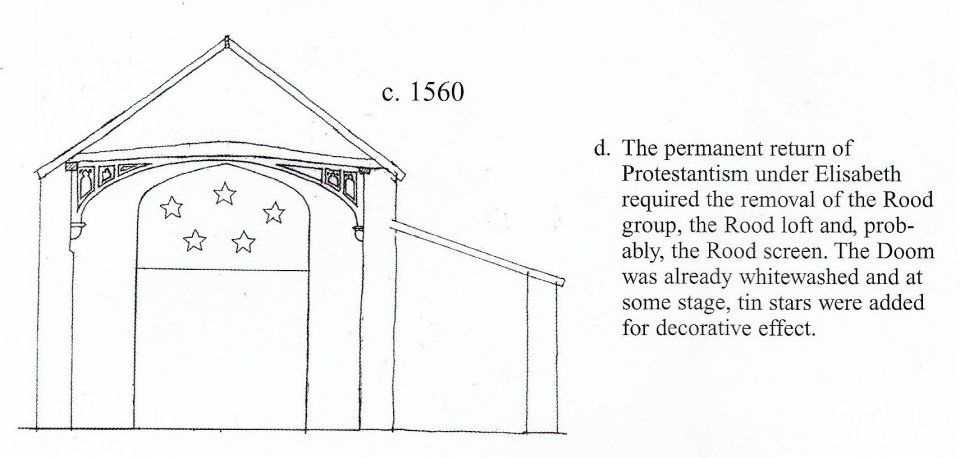
-
In 1558 (Fig. 7d), after the accession of Elizabeth, the return of Protestantism required the permanent concealment of the Doom again under a coat of limewash and the removal of the Rood loft and probably the Rood screen as well.
-
In 1637, the reference to ‘the wainscot which is over the separation of church and chancel’, which was in need of repair, would seem to refer to the concealed Doom still in its original position and suggests that it was still recognisably wood rather than plaster.29 It sounds as if some of the planks may already have been broken, which could explain Clive Rouse’s failure to find all the pieces in 1938, despite great efforts.

-
In the 1730s (Fig. 7e), the medieval roof of the nave was raised by 3 feet or so, and the chancel arch was widened a little to the south and rebuilt at the top in brick as a segmental arch. The whitewashed Doom was removed from below the chancel arch and trimmed, but only a little, to fit m its present position above the arch. Its origin was probably unrecognised and it was considered merely as a sound piece of wood of the right size to cover the new brick wall at the top of the nave, which is only one 9 inch brick thick. It may well have been at this stage that the lath and plaster was added to cover damaged boarding and to give more protection to an outside wall. H.B.Ziegler’s painting shows what the chancel looked like at this stage (Fig.8).
-
In 1865, the Victorian ‘restoration’, aimed to restore the medieval focus on the chancel by removing the 3-decker pulpit from the chancel, and rebuilding a new east wall with a Gothic east window. The chancel arch was not affected and the Doom remained concealed under a covering of laths and plaster until the chance discovery of 1938.
-
ACKNOWLEDGEMENTS
The painstaking and expensive work on the Doom was possible only with the generous support of the Church of England’s Council for the Care of Churches, and a number of charitable bodies: the Manifold Trust, the Francis Coales Charitable Foundation and the Penn Trust.
I am most grateful to Ruth Bubb, the conservator, for much useful discussion during several visits; to Catharine Hassall, a paint analyst, for her report and discussion of her examination of the paint layers; to Ian Tyers of ARCUS Dendrochronological Laboratory of the University of Sheffield for his report and advice on the tree ring analysis; to Ann Ballantyne, an expert on wall-paintings, who was once Clive Rouse’s assistant for her visit and discussion of possible explanations; and to Sir Oliver Millar, Surveyor Emeritus of the Queen’s Pictures and an active member of our Doom group, for many discussions and useful criticism of the text.
Miles Green, Records of Buckinghamshire, Vol. 44, 2004
REFERENCES
- Dr E. Clive Rouse, who lived in Gerrards Cross was Asst Editor of Records 1934-46, Edito; 1947-69. He was Vice President of the Bucks Arch. Soc. 1961-9 and President 1969-79. See Elliot Viney, , A history of the Society’, Recs. Bucks 38 (1996), p. 124. He was also President of the Royal Archaeological Institute.
- E. C. Rouse, ‘Painting in Penn Church’, Recs. Bucks, XIII, (1939–40), p. 362 and E. Clive Rouse, ‘The Penn Doom’, Recs. Bucks, XVII, Pt 2, (1962), pp. 95-104.
- Ruth Bubb’s overall report on the project is Bubb R., The Penn Doom, Unpublished conservation report (2002). Copies in Penn Church archives: Bucks County Record Office: Council for the Care of Churches: National Monuments Register. It contains the following appendices:
I. Ian Tyers, ‘Tree ring analysis’, Project Report 572dII
II. Catherine Hassall, ‘An examination of the paint layers’, Report X343b
III. Clare Richardson, ‘Creation of the digital Image of the first painted scheme’
IV. Miles Green, ‘The architectural and historical evidence’
V. Ruth Bubb, ‘The Penn Doom, Condition Report (1999)’
Also by Ruth Bubb, ‘The Penn Doom: the re-examination and conservation of an important medieval painting on wood’, The Conservator 27 (2003) - A detailed analysis of windows, doors and graves and entries in the parish register all confirm the accuracy of the drawing. It was drawn before 1724 when the register records ‘the Little House adjoining to the Tower was built to hold the Bier & Tools belonging to the Church, & mortar & Bricks & Tiles which before were used to be laid near the font’. This Little House can be seen in Fig. 5, but not in Fig. 4. Judging from the neglected state of the roof tiles the drawing was also made before the arrival’ of a very energetic Vicar, John Bennet, in 1700.
- Holy Trinity, Penn, Annual Report 1929. The chancel was ‘added to’ i.e. extended, in 1736. There is a copy of the lithograph in the church archives.
- Bishop’s Visitation report, Recs. Bucks VII, p.257.
- The eighteenth century view is reproduced in J. G. Jenkins, A History of the Parish of Penn, St Catherine Press, London (1935), facing page 138. The nineteenth century view is from a painting in c.1850, by H. B. Ziegler (17931874), who was Drawing Master to Queen Adelaide for eight years. The original hangs in Penn House.
- Bishop’s Visitation report, op. cit., p.257.
- The register book records, ‘In February 1733, the arch against the Pulpit was enlarged’. A brass plaque also records the same date. In 1637, these pews had been ‘2 yards and a ½ high’, covered and standing into the middle of the chancel with a similar one in the south aisle. The Curzon pew was still described as highbacked in 1899, but a photograph shows it was modest compared with its predecessor.
- It was this extension which allowed a new Penn family vault to be dug under the east end of the chancel in 1797 – reported in a letter, dated 9 Aug 1802, from Rev. John Middleton, Vicar of Penn, Lyson’s Bucks correspondence, BM Ms Add 9411, f205.
- The parish register records that, in 1714, Roger Penn ’caused the Chancel to be wainscotted & Railed in at his own charges.’ To modem ears this may sound like wooden wainscotted walls and an altar rail, but Aymer Vallance, English Church Screens, Batsford, London (1936), p. 32, states that late medieval bequests for ‘making a chapel of wainscot’ refers to the oak screens enclosing a chapel. He also points out that the name chancel itself means ‘railing’ from Latin cancellus.
- Francis Bond, An Introduction to English Church Architecture, 11th C to 16th C, OUP, London (1913), pp. 437,439. G.H.Cook, The English Medieval Parish Church, Phoenix House, London (1954), p. 229, gives an example of depressed four-centred nave arches in Whiston, Northants, dated 1380~1400.
- Aymer Vallance, op. cit., p. 16 and G. H. Cook, op. cit.,p.15\.
- Courts of the Archdeaconry of Buckingham 1483-1523, Bucks Rec. Soc.,19 (1975), p. 242 and J. G. Jenkins. History of Penn (1936), p. 83
- E. Clive Rouse, ‘The Penn Doom’, Recs. Bucks XVII, Pt2 (1962), p. IO\.
- Aymer Vallance, op. cit., p. 66 and G.H.Cook, op. cit.,p. 157.
- Aymer Vallance, op. cit., p. 8, quotes a Marian bishop requiring ‘A decent Rood of five feet in length with Mary and John’.
- Aymer Vallance, op. cit., p. 68, has no doubts about this and maintains that the real reason for the order to remove rood lofts after the Reformation was to ‘restrain all curious singing and music’, which in Puritan eyes was a sensuous, ungodly pleasure. The Welsh loved their singing so much that that they defied the order and have kept many of their lofts to this day. The eighteenth century choir gallery over Penn’s south door can be seen as a belated replacement for the rood loft. However, in 1. M. Neale & B. Webb, Churches and Church Ornaments, Gibbings & Co, London (1906), p. 167, William Durandus, the much quoted thirteenth century French bishop and canon lawyer, describes a procession to the Rood loft, led by a deacon, to read the Gospel. Perhaps this was the practice in larger continental churches but not apparently in small parish churches.
- The 34 year span, between 1414 and 1448, represents the estimated highest and lowest number of rings likely to have been on the missing sapwood.
- Ian Tyers, the dendrochronologist from the University of Sheffield who examined the Doom and wrote the report (See fn.3 above), contrasted the much more sophisticated products of the professional Dutch panel makers of the same period, who used straight, slow growing, Baltic oak to make perfectly square and straight boards which butted together precisely, with inside edge to inside edge and outside edge to outside edge.
- Catherine Hassall, ‘An examination of the paint layers’. Report X343b. (See fn.3 above)
- Clare Richardson, ‘Creation of the digital image of the first painted scheme’. (See fn.3 above)
- Another possibility suggested by Ann Ballantyne is that the repainted Doom was repositioned 4 or 5 ft higher, straddling the tie beam, in order to allow room for a small Rood group hanging beneath it and overlapping on to the bottom of the Doom. The forcible removal of the Rood after 1547 would then explain the broken central plank. However, this arrangement would negate the light blocking purpose of the tympanum and leave the Rood group haloed against the light from the chancel. The central plank could have been broken long after the Reformation, either in its move in the 1730s or perhaps by the rough removal in 1938.
- Early Taxation Returns, Bucks Rec. Soc. 14 (1966), p. 45, records all the taxpayers of Penn in 1332. Simon Ie Pavyer was second only to John de la Penne and John and Henry le Tyzler were the 7th and 9th most prosperous.
- VCH Bucks (1925), III, p. 240. Chalcombe Priory successfully appealed to Rome, in 1344, that they might take possession of the church after the death or resignation of the rector, without leave of the bishop, However, Aymer Vallance, op. cit., pp. 214, 227, maintains that non-resident religious houses were usually in debt from the thirteenth century and generally did as little and as late as possible to the chancel which was their responsibility as proprietors. Work done even soon after they took over a church was seldom at their initiative or funding.
- I measured this distance when the chancel roof was being repaired recently. It is a 45° roof slope and so an 18 inch movement of the ridge requires a 3ft movement of the walls. This was an unusual way of widening a chancel. Normally, the new and larger chancel would be built completely around the earlier one, which was then removed. This was to allow almost continuous use of the chancel.
- RCHM and Pevsner agree on this dating. 28.1)
- Dictionary of National Biography, 13.p.555.
- Bishop’s Visitation Report, op. cit. (See fn.6)

